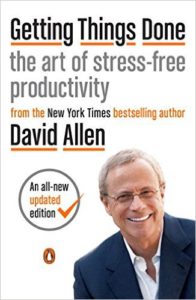There are many ways to approach the tasks on your to-do list. The relative urgency of tasks can’t fail to play a role. The importance of tasks should play a greater role. But in this post I want to focus on an often-overlooked aspect of task-management: context. Most tasks are well-suited to being worked on in certain environments but ill-suited to others. Working on tasks optimally suited to the context you are in at any given time can greatly increase your overall work efficiency.

In this post I’ll explain what I mean by “context” and show how to increase efficiency by choosing tasks well-suited to any given context.
Definition of “Context”
By “context” I mean the environment in which you can work on a task. “Environment” includes aspects such as:
- Your physical location: e.g., at home, in the office, in the car, etc.
- Who you are with: e.g., with your spouse, your boss, a direct report, etc.
- What equipment is available to you: e.g., a computer, Wi-Fi, a cell phone signal, etc.
My Emerging Awareness of Context
When it comes to getting stuff done, I don’t know about you, but my preference would be to work on whatever I feel like working on at any given time. So basically the same attitude my five-year-old daughter has.
But that preference doesn’t lead to the best results.
It was, actually, when my daughter was born that I started thinking a lot more about context and experimenting with it. With my added responsibilities in terms of taking care of her, I had less disposable time and was looking to get more efficient.
One of the things I did was have my iPhone read to me at the fastest rate I could understand. That helped in many contexts. But I took it too far.
During my hour-long commute, I had my iPhone read my email to me through my Bluetooth stereo. I called the setup my “mobile office.” Because that’s the sort of thing cool people think about and give a name to.
But soon I saw the shortcomings of my so-called “mobile office.” I found myself constantly handling my phone, trying to get it to repeat something, or voice-dictating a reply email into it. It was clumsy, awkward, and probably not especially safe.
I was processing more email, but in a very inefficient way. What I could have done in 20 minutes in front of a computer was taking an hour in the car. The context was ill-suited to that particular task.
I decided to leave email for another context and find something else to do in the car that was more optimally suited to that environment (which I will detail in a future post).
Why Context is Important
A few years later I read David Allen’s excellent book on productivity, Getting Things Done. Allen provides the following framework for why context is important:
“You are always constrained by what you have the capability to do at this time. A few actions can be done anywhere (such as drafting ideas about a project with pen and paper), but most require a specific location (at home, at your office) or having some productivity tool at hand, such as a phone or a computer. These are the first factors that limit your choices about what you can do in the moment.”
As Allen frames it, context is important because it determines what you can or cannot do in the moment. You can’t make phone calls in an airplane. You can’t have a one-on-one discussion with a certain person if he or she isn’t there.
Stated more positively, I’d say: for every context there are certain tasks optimally suited to that context. All other things being equal, those are the tasks you should focus on in that context.
When you’re one-on-one with your supervisor or a direct report, focus on the profitable conversations you can have with them. When you’re at your computer, focus on the tasks that benefit most from you having a keyboard, mouse, and monitor. And so forth.
How to Match Tasks with their Optimal Context
Here are two ways to match tasks with the context in which they are most optimally executed:
- The abstract approach. Think through the contexts in which you spend your day. For me, such contexts include getting ready for work, in the car, at the computer in my company’s office, in meetings, in my home office, watching TV in my bedroom, etc. Think through what types of tasks are most suited to those environments. And commit to focusing on those types of tasks when you’re in those contexts.
- The concrete approach. Whenever you record a task on your to-do list, indicate the context in which that task can most easily be accomplished. Then, unless the task is super-urgent, don’t work on it until you are in that context. Such discipline can be hard—for five-year-olds and their fathers alike. But it will lead to productivity gains. By way of analogy, it would be like leaving nails sticking out until you have a hammer in hand rather than trying to whack the nails in with your shoe, because you’ll get the job done faster with the hammer.
Question: What do you think is the optimal context in which to process email? I’d love to hear your thoughts. You can leave a comment by clicking here.
If you liked this post, why not join the 5,000+ subscribers who receive blog updates on how to have more time and money for what matters most? Sign up here.

